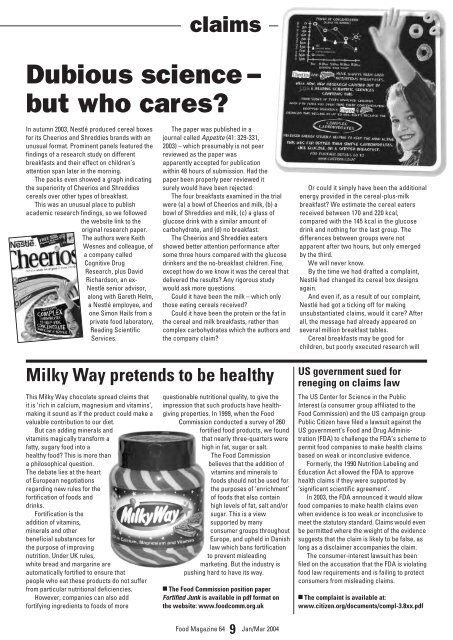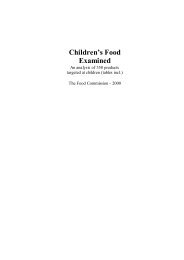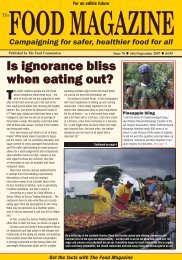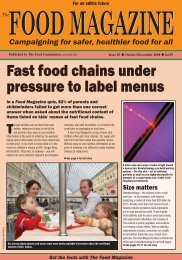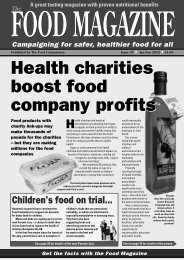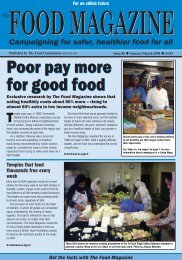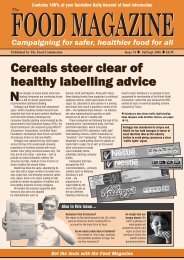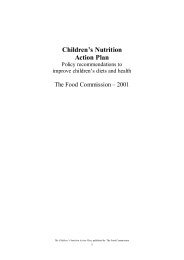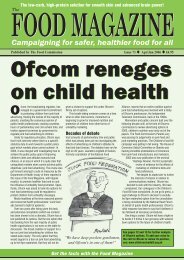Soft drinks - The Food Commission
Soft drinks - The Food Commission
Soft drinks - The Food Commission
- No tags were found...
Create successful ePaper yourself
Turn your PDF publications into a flip-book with our unique Google optimized e-Paper software.
claimsDubious science –but who cares?In autumn 2003, Nestlé produced cereal boxesfor its Cheerios and Shreddies brands with anunusual format. Prominent panels featured thefindings of a research study on differentbreakfasts and their effect on children’sattention span later in the morning.<strong>The</strong> packs even showed a graph indicatingthe superiority of Cheerios and Shreddiescereals over other types of breakfast.This was an unusual place to publishacademic research findings, so we followedthe website link to theoriginal research paper.<strong>The</strong> authors were KeithWesnes and colleague, ofa company calledCognitive DrugResearch, plus DavidRichardson, an ex-Nestlé senior advisor,along with Gareth Helm,a Nestlé employee, andone Simon Hails from aprivate food laboratory,Reading ScientificServices.<strong>The</strong> paper was published in ajournal called Appetite (41: 329-331,2003) – which presumably is not peerreviewed as the paper wasapparently accepted for publicationwithin 48 hours of submission. Had thepaper been properly peer reviewed itsurely would have been rejected.<strong>The</strong> four breakfasts examined in the trialwere (a) a bowl of Cheerios and milk, (b) abowl of Shreddies and milk, (c) a glass ofglucose drink with a similar amount ofcarbohydrate, and (d) no breakfast.<strong>The</strong> Cheerios and Shreddies eatersshowed better attention performance aftersome three hours compared with the glucosedrinkers and the no-breakfast children. Fine,except how do we know it was the cereal thatdelivered the results? Any rigorous studywould ask more questions.Could it have been the milk – which onlythose eating cereals received?Could it have been the protein or the fat inthe cereal and milk breakfasts, rather thancomplex carbohydrates which the authors andthe company claim?Or could it simply have been the additionalenergy provided in the cereal-plus-milkbreakfast? We estimate the cereal eatersreceived between 170 and 220 kcal,compared with the 145 kcal in the glucosedrink and nothing for the last group. <strong>The</strong>differences between groups were notapparent after two hours, but only emergedby the third.We will never know.By the time we had drafted a complaint,Nestlé had changed its cereal box designsagain.And even if, as a result of our complaint,Nestlé had got a ticking off for makingunsubstantiated claims, would it care? Afterall, the message had already appeared onseveral million breakfast tables.Cereal breakfasts may be good forchildren, but poorly executed research willMilky Way pretends to be healthyThis Milky Way chocolate spread claims thatit is ‘rich in calcium, magnesium and vitamins’,making it sound as if the product could make avaluable contribution to our diet.But can adding minerals andvitamins magically transform afatty, sugary food into ahealthy food? This is more thana philosophical question.<strong>The</strong> debate lies at the heartof European negotiationsregarding new rules for thefortification of foods and<strong>drinks</strong>.Fortification is theaddition of vitamins,minerals and otherbeneficial substances forthe purpose of improvingnutrition. Under UK rules,white bread and margarine areautomatically fortified to ensure thatpeople who eat these products do not sufferfrom particular nutritional deficiencies.However, companies can also addfortifying ingredients to foods of morequestionable nutritional quality, to give theimpression that such products have healthgivingproperties. In 1999, when the <strong>Food</strong><strong>Commission</strong> conducted a survey of 260fortified food products, we foundthat nearly three-quarters werehigh in fat, sugar or salt.<strong>The</strong> <strong>Food</strong> <strong>Commission</strong>believes that the addition ofvitamins and minerals tofoods should not be used forthe purposes of ‘enrichment’of foods that also containhigh levels of fat, salt and/orsugar. This is a viewsupported by manyconsumer groups throughoutEurope, and upheld in Danishlaw which bans fortificationto prevent misleadingmarketing. But the industry ispushing hard to have its way.■ <strong>The</strong> <strong>Food</strong> <strong>Commission</strong> position paperFortified Junk is available in pdf format onthe website: www.foodcomm.org.ukUS government sued forreneging on claims law<strong>The</strong> US Center for Science in the PublicInterest (a consumer group affiliated to the<strong>Food</strong> <strong>Commission</strong>) and the US campaign groupPublic Citizen have filed a lawsuit against theUS government’s <strong>Food</strong> and Drug Administration(FDA) to challenge the FDA’s scheme topermit food companies to make health claimsbased on weak or inconclusive evidence.Formerly, the 1990 Nutrition Labeling andEducation Act allowed the FDA to approvehealth claims if they were supported by‘significant scientific agreement’.In 2003, the FDA announced it would allowfood companies to make health claims evenwhen evidence is too weak or inconclusive tomeet the statutory standard. Claims would evenbe permitted where the weight of the evidencesuggests that the claim is likely to be false, aslong as a disclaimer accompanies the claim.<strong>The</strong> consumer-interest lawsuit has beenfiled on the accusation that the FDA is violatingfood law requirements and is failing to protectconsumers from misleading claims.■ <strong>The</strong> complaint is available at:www.citizen.org/documents/compl-3.8xx.pdf<strong>Food</strong> Magazine 64 9 Jan/Mar 2004


